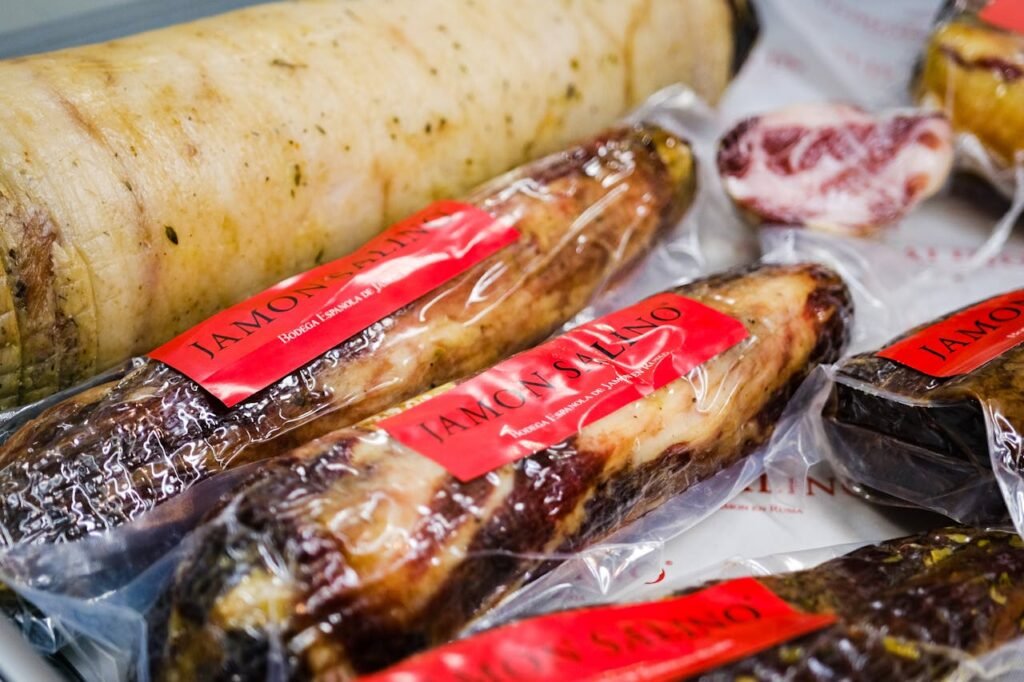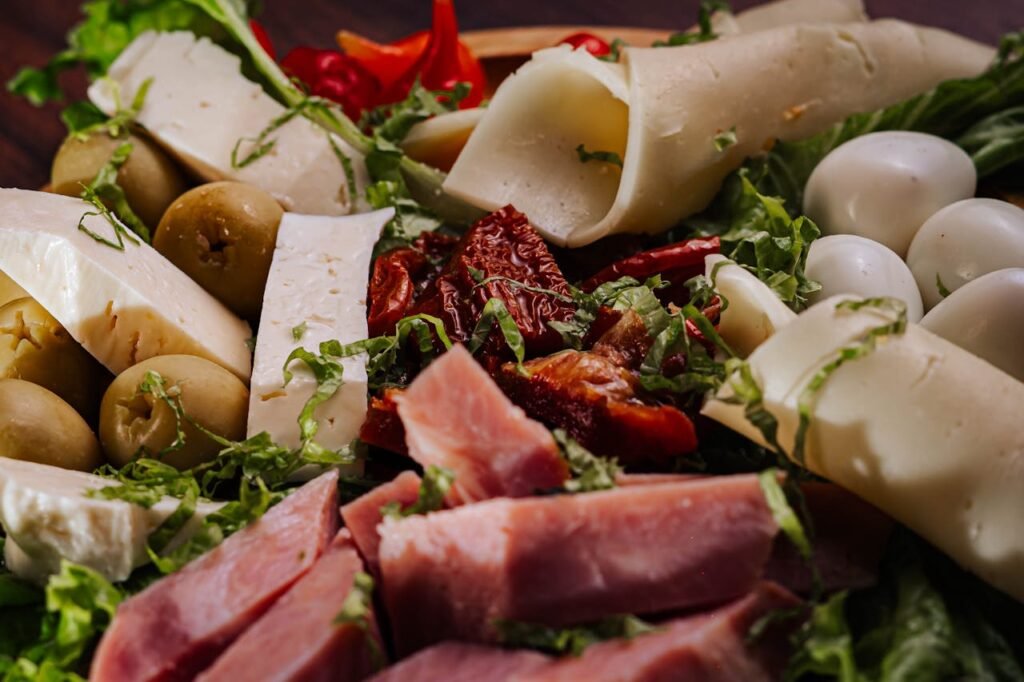Italian Deli Meats: Pairing Secrets with Wine, Cheese, and Artisanal Breads

Italian Deli Meats: Pairing Secrets with Wine, Cheese, and Artisanal Breads
Introduction to Italian Deli Meats: A Culinary Heritage
Italian deli meats represent one of Italy’s most celebrated culinary traditions, with techniques perfected over centuries of craftsmanship. These cured meats, collectively known as salumi, showcase Italy’s remarkable regional diversity and commitment to quality. From the delicate, buttery texture of Prosciutto di Parma to the bold, spicy kick of Calabrian ‘Nduja, Italian deli meats offer an extraordinary range of flavours, textures, and aromas that have captivated food enthusiasts worldwide.
The art of preparing Italian deli meats dates back to ancient Roman times when curing techniques were developed as practical methods of preservation. Today, these methods have evolved into sophisticated culinary practices that vary dramatically from region to region. Northern Italian specialties like Bresaola from Lombardy contrast sharply with southern treasures like Capocollo from Calabria, each reflecting local climate, traditions, and taste preferences.
- Traditional Italian deli meats are categorised into two main groups:
- Salumi (whole-muscle cuts like prosciutto and bresaola)
- Insaccati (ground meat products encased in natural casings like salami)
- Key factors that influence the distinctive character of Italian deli meats include:
- Regional climate and terroir
- Specific breeds of animals used
- Family recipes passed through generations
- Aging processes that can range from weeks to years
Understanding the rich heritage behind Italian deli meats enhances the appreciation of their complex flavours and textures. Each slice tells a story of tradition, craftsmanship, and regional pride. Whether enjoyed as part of an elaborate antipasto platter or tucked into a rustic sandwich, these specialties represent Italy’s extraordinary food culture.
The true magic of Italian deli meats emerges when they’re thoughtfully paired with complementary flavours. The right wine, cheese, and bread can elevate these cured specialties to new heights, creating harmonious combinations that highlight their unique characteristics. In this comprehensive guide, we’ll explore the secrets to creating perfect pairings that showcase the remarkable versatility and depth of Italian deli meats.

Essential Italian Deli Meats: Understanding the Classics
Italian deli meats form the cornerstone of Italy’s celebrated salumi tradition, with each variety offering distinct characteristics that reflect regional specialties and time-honoured production methods. Understanding these classics is essential for creating thoughtful pairings that showcase their unique qualities. From the delicate sweetness of prosciutto to the robust spice of soppressata, Italian deli meats present a fascinating spectrum of flavours and textures.
- Prosciutto di Parma: Perhaps the most famous of all Italian deli meats, this ham from Emilia-Romagna is aged for at least 12 months, resulting in paper-thin slices with a perfect balance of sweetness and saltiness. The pigs are fed a diet that includes whey from Parmigiano-Reggiano production, creating a beautiful symbiosis between two iconic products.
- Mortadella: This smooth, delicate sausage from Bologna features finely ground pork studded with cubes of fat and sometimes pistachios. Despite being imitated worldwide (most notably as “bologna” in America), authentic Italian mortadella offers a refined, subtle flavour profile that bears little resemblance to its international counterparts.
- Bresaola: Unlike most Italian deli meats, bresaola is made from beef rather than pork. This air-dried, salted beef from Lombardy has a distinctive deep red colour and slightly sweet, aromatic flavour. Its lean character makes it a lighter alternative to many pork-based options.
- Salami Milano: This fine-grained salami features a balanced blend of lean meat and fat, seasoned simply with garlic and pepper. Its mild flavour and uniform texture make it exceptionally versatile for pairings.
- Coppa/Capocollo: Made from the muscle running from the neck to the ribs of the pig, this delicacy is seasoned with various spices and wines depending on the region. After curing, it develops complex flavours ranging from delicate to robust.
- ‘Nduja: This spreadable spicy sausage from Calabria represents the bolder side of Italian deli meats. Made with generous amounts of Calabrian chilli peppers, it offers intense heat balanced with rich pork flavour.
- Pancetta: Often described as Italian bacon, pancetta is cured pork belly that’s rolled into a cylinder. Unlike American bacon, it’s not smoked but simply cured with salt and spices, resulting in a purer pork flavour.
- Speck: This distinctive meat from the Alto Adige region combines Mediterranean curing methods with the smoking techniques of the Alps. The result is a uniquely flavoured ham with subtle juniper and smoke notes.
The quality of Italian deli meats depends significantly on traditional production methods that respect time-honoured techniques. Many premium varieties carry Protected Designation of Origin (DOP) or Protected Geographical Indication (IGP) certifications, guaranteeing authentic production within specific regions using traditional methods. These designations help preserve the integrity and heritage of classic Italian deli meats while ensuring consumers receive genuine products with characteristic regional qualities.
Wine Pairing Secrets with Italian Deli Meats
Italian deli meats shine brightest when paired with the right wines, creating harmonious combinations that enhance the flavours of both elements. The art of pairing these cured specialties with wine follows certain principles while leaving room for personal exploration and preference. Understanding how the characteristics of different Italian deli meats interact with various wine styles unlocks countless delicious possibilities for your antipasto platters and charcuterie boards.
The fundamental approach to pairing Italian deli meats with wine considers several key factors:
- Fat content: Fattier meats like mortadella pair beautifully with wines that have higher acidity to cut through the richness
- Salt levels: Salt-forward meats such as prosciutto work well with slightly sweeter wines that balance the salinity
- Spice intensity: Spicy varieties like soppressata or ‘nduja call for wines with enough body to stand up to their heat
- Regional connections: Following the “what grows together goes together” principle often yields excellent results
Here are specific wine pairings for popular Italian deli meats:
- Prosciutto di Parma
- Ideal pairings: Prosecco, Lambrusco, Franciacorta
- Why it works: The delicate sweetness and saltiness of prosciutto is complemented by the crisp acidity and subtle sweetness of these sparkling wines
- Alternative option: A light-bodied Pinot Noir offers a still wine alternative
- Bresaola
- Ideal pairings: Valtellina Superiore, Chianti Classico
- Why it works: The lean, aromatic beef qualities match well with medium-bodied reds with good acidity
- Alternative option: A dry rosé provides a refreshing counterpoint
- Spicy Salami (Soppressata, ‘Nduja)
- Ideal pairings: Primitivo, Nero d’Avola, Montepulciano d’Abruzzo
- Why it works: These fuller-bodied reds stand up to the spice while their fruit-forward profiles complement the heat
- Alternative option: An off-dry Riesling can provide interesting contrast
- Mortadella
- Ideal pairings: Pignoletto, Vermentino, Soave
- Why it works: The delicate flavour and creamy texture of mortadella pairs well with crisp whites that refresh the palate
- Alternative option: A fruity Lambrusco from mortadella’s home region
| Italian Deli Meat | Wine Style | Specific Recommendations | Key Pairing Principle |
|---|---|---|---|
| Prosciutto di Parma | Sparkling/Light Red | Prosecco, Franciacorta, Light Pinot Noir | Acidity balances salt |
| Bresaola | Medium-Bodied Red | Valtellina Superiore, Chianti Classico | Complementary regional pairing |
| Spicy Salami | Full-Bodied Red | Primitivo, Nero d’Avola | Body matches intensity |
| Mortadella | Crisp White | Pignoletto, Soave | Refreshes palate |
| Speck | Aromatic White | Gewürztraminer, Kerner | Aromatic complement |
When hosting a gathering featuring multiple Italian deli meats, consider offering 2-3 wine options that can work across different selections. A versatile Sangiovese-based wine, a crisp white like Vermentino, and perhaps a sparkling option like Prosecco provide enough variety to complement most Italian deli meats while keeping the selection manageable.
Remember that the best Italian deli meat and wine pairings often follow regional traditions – the local wines of an area typically evolved alongside its food specialties, creating natural affinities. This “territorial pairing” approach rarely disappoints and offers an authentic taste of Italy’s diverse culinary landscape.
Cheese Companions for Italian Deli Meats
Italian deli meats find perfect harmony when paired with the right cheeses, creating combinations that highlight the unique characteristics of both. The art of matching these cured specialties with complementary cheeses involves balancing flavours, textures, and intensities to create a cohesive tasting experience. From the creamy softness of fresh mozzarella to the crystalline crunch of aged Parmigiano-Reggiano, Italian cheeses offer countless possibilities for elevating your salumi selections.
When pairing cheeses with Italian deli meats, consider these fundamental principles:
- Intensity matching: Pair delicate meats with milder cheeses and robust meats with stronger cheeses
- Textural contrast: Combine different textures for interest (e.g., creamy cheese with firmer meats)
- Regional authenticity: Cheeses and meats from the same Italian regions often have natural affinity
- Flavour complementarity: Look for flavours that enhance rather than overwhelm each other
Here are exceptional cheese pairings for classic Italian deli meats:
- Prosciutto di Parma
- Perfect pairs: Mozzarella di Bufala, Burrata, young Pecorino Toscano
- Why it works: The saltiness of prosciutto is beautifully balanced by the milky sweetness of fresh cheeses
- Serving tip: Drizzle with high-quality olive oil to enhance the pairing
- Bresaola
- Perfect pairs: Caprino (goat cheese), Robiola, Taleggio
- Why it works: The lean, aromatic quality of bresaola pairs wonderfully with tangy, complex cheeses
- Serving tip: Add a squeeze of lemon and cracked black pepper to bresaola before serving
- Spicy Salami (Soppressata, Calabrese)
- Perfect pairs: Provolone Piccante, aged Pecorino Romano, Gorgonzola Piccante
- Why it works: The boldness of these cheeses stands up to the spice while providing complementary flavour profiles
- Serving tip: A small pot of honey nearby allows guests to add a sweet contrast that tames the heat
- Mortadella
- Perfect pairs: Stracchino, young Asiago, Ricotta Salata
- Why it works: The delicate flavour of mortadella pairs well with softer, milder cheeses that don’t overwhelm it
- Serving tip: Serve at room temperature to fully appreciate the subtle flavours
- Speck
- Perfect pairs: Fontina Valle d’Aosta, Montasio, Asiago d’Allevo
- Why it works: The smoky, aromatic qualities of speck complement the nutty, alpine character of these northern Italian cheeses
- Serving tip: A small dish of mostarda (Italian candied fruit preserves) enhances this pairing
When creating a comprehensive antipasto platter featuring multiple Italian deli meats, include a thoughtful selection of 3-5 cheeses that offer variety in terms of:
- Milk type: Mix cow, sheep, and goat milk cheeses
- Texture: Include soft, semi-firm, and hard options
- Age profiles: Combine fresh, medium-aged, and well-aged selections
- Flavour intensity: Provide mild, medium, and bold choices
The temperature of cheese significantly impacts its flavour profile when paired with Italian deli meats. Always serve cheese at room temperature (remove from refrigeration 30-60 minutes before serving) to fully appreciate its nuances. This simple step dramatically improves the pairing experience by allowing the full range of flavours to emerge.
Italian deli meats and cheeses together create a celebration of Italy’s remarkable food culture. These thoughtful combinations offer a delicious way to explore regional specialties and discover new favourite pairings that showcase the extraordinary diversity of Italian gastronomy.

Artisanal Bread Selections for Italian Deli Meats
Italian deli meats find their perfect canvas in quality artisanal breads that complement their complex flavours and textures. The right bread selection elevates these cured specialties, creating a harmonious balance that showcases the unique characteristics of both elements. From the crisp crust of ciabatta to the dense chew of pagnotta, Italian bread traditions offer countless possibilities for enhancing your salumi experience.
The ideal bread for Italian deli meats should provide both structural support and flavour enhancement without overwhelming the meat’s subtle nuances. Consider these key factors when selecting bread pairings:
- Crust-to-crumb ratio: Breads with a good balance of crust and interior texture offer the best eating experience
- Flavour profile: Mild, slightly tangy breads generally work better than intensely flavoured varieties
- Structural integrity: The bread should hold up to the moisture and fat content of the meats
- Regional authenticity: Pairing meats with breads from the same Italian regions often yields excellent results
Here are exceptional bread pairings for classic Italian deli meats:
- Ciabatta
- Perfect with: Prosciutto di Parma, Mortadella, Coppa
- Why it works: The airy interior and crisp crust provide textural contrast while the mild flavour lets the meats shine
- Serving suggestion: Lightly toast and drizzle with olive oil before topping with meats
- Focaccia
- Perfect with: Bresaola, Speck, Salami Milano
- Why it works: The olive oil-enriched dough and aromatic herbs complement these flavourful meats
- Serving suggestion: Serve at room temperature, allowing the bread’s olive oil to meld with the meats
- Pane Pugliese
- Perfect with: Robust salamis, ‘Nduja, Soppressata
- Why it works: This rustic bread from Puglia has a sturdy structure and slightly fermented flavour that stands up to stronger meats
- Serving suggestion: Slice thinly and lightly toast for optimal texture
- Schiacciata
- Perfect with: Finocchiona, Prosciutto Cotto, delicate salamis
- Why it works: This Tuscan flatbread’s salt and olive oil notes enhance the meats without competing
- Serving suggestion: Serve slightly warm to release its aromatic qualities
- Grissini
- Perfect with: All Italian deli meats, especially when wrapped
- Why it works: These crisp breadsticks provide textural contrast and a convenient vessel for enjoying thinly sliced meats
- Serving suggestion: Wrap prosciutto or bresaola around the breadsticks for an elegant presentation
For creating memorable sandwiches featuring Italian deli meats, consider these artisanal bread options:
- Ciabatta Rolls: Perfect for substantial sandwiches with multiple meats and accompaniments
- Rosetta Rolls: Their distinctive shape and soft interior make them ideal for simple, meat-forward sandwiches
- Stirato: This Italian baguette variation offers a crisp crust and open crumb structure that works beautifully with most Italian deli meats
When serving bread with Italian deli meats, consider these presentation tips:
- Slice breads just before serving to maintain freshness
- Offer a variety of thicknesses to accommodate different preferences
- Include both room temperature and lightly toasted options
- Arrange breads in a separate basket with proper serving utensils
- Consider providing high-quality olive oil and balsamic vinegar for optional drizzling
The quality of bread makes a significant difference when enjoying Italian deli meats. Seek out authentic artisanal varieties from quality bakeries that use traditional fermentation methods and simple ingredients. These breads develop complex flavours that complement rather than compete with the nuanced taste of fine Italian deli meats, creating a truly exceptional culinary experience.
Creating the Perfect Italian Antipasto Platter
Italian deli meats form the cornerstone of a traditional antipasto platter, that magnificent first course that welcomes guests with an array of flavours, textures, and colours. Creating the perfect antipasto featuring Italian deli meats is both an art and a science, requiring thoughtful selection and arrangement to showcase these cured specialties at their best. When properly executed, an antipasto platter becomes more than just appetizers—it transforms into a convivial celebration of Italy’s remarkable food culture.
The key to an exceptional antipasto platter lies in balancing variety with harmony. Follow these guidelines to create a memorable presentation:
- Selection Principles
- Include 3-5 different Italian deli meats varying in texture, flavour intensity, and region
- Balance delicate options (prosciutto, mortadella) with more robust choices (salami, coppa)
- Consider visual appeal by incorporating different colours and shapes
- Aim for approximately 50-75g of meat per person as part of a larger meal
- Arrangement Techniques
- Create height and visual interest by folding or rolling sliced meats
- Arrange prosciutto in loose, elegant folds that showcase its translucent quality
- Roll thicker-cut meats like mortadella into cylinders
- Fan out sliced salami in overlapping patterns
- Place spreadable options like ‘nduja in small serving bowls with appropriate utensils
- Complementary Additions
- Marinated vegetables: artichoke hearts, roasted red peppers, olives
- Fresh elements: cherry tomatoes, fresh basil leaves, fig halves
- Nuts: toasted almonds, walnuts, or pistachios
- Preserves: fig jam, mostarda, or honey for contrasting sweetness
- Pickled items: giardiniera, pickled onions, or caperberries
For a truly spectacular presentation, consider these professional styling tips:
- Use a wooden board, marble slab, or terracotta platter as your base
- Arrange items in groups rather than scattering them randomly
- Create visual pathways that guide the eye across the platter
- Include small bowls for olives, nuts, and spreads to add height variation
- Add fresh herbs like rosemary sprigs or basil leaves as aromatic garnishes
- Provide appropriate serving utensils for each component
When planning quantities, use this approximate guide per person:
- 50-75g total Italian deli meats
- 50g cheese
- 30g olives and marinated vegetables
- 2-3 slices of artisanal bread or 3-4 grissini
The temperature of the components significantly impacts the antipasto experience. Remove Italian deli meats from refrigeration about 30 minutes before serving to allow their flavours to fully develop. Cold temperatures mute the nuanced flavours that make these specialties so remarkable.
A thoughtfully composed antipasto featuring quality Italian deli meats creates an immediate impression of abundance and care. It invites conversation, encourages sharing, and sets the tone for the meal to follow. This centuries-old tradition of beginning a meal with an array of cured specialties continues to delight modern diners with its perfect balance of simplicity and sophistication.
FAQ: Italian Deli Meats and Perfect Pairings
What’s the best way to store Italian deli meats at home?
For optimal freshness, store Italian deli meats in the refrigerator wrapped in butcher paper or wax paper rather than plastic wrap, which can trap moisture. Consume sliced meats within 3-5 days. For longer storage, keep whole pieces vacuum-sealed in their original packaging until ready to use. Always allow meats to come to room temperature for about 30 minutes before serving to enhance their flavours.
How do I create a balanced Italian charcuterie board?
Create a balanced board by including 3-5 different types of Italian deli meats with varying textures and flavour intensities. Include both mild options (prosciutto, mortadella) and more robust choices (salami, coppa). Add complementary items like 2-3 cheeses, olives, marinated vegetables, fresh fruit, and artisanal bread. Aim for approximately 50-75g of meat per person as part of a larger meal.
What wines pair best with spicy Italian salamis?
Spicy Italian salamis like Calabrese or soppressata pair beautifully with bold red wines that can stand up to their heat. Try a Primitivo, Nero d’Avola, or Montepulciano d’Abruzzo. These fuller-bodied reds complement the spice while their fruit-forward profiles balance the heat. For an interesting contrast, an off-dry Riesling can also work surprisingly well.
Can I serve Italian deli meats with non-Italian cheeses?
Absolutely! While traditional Italian pairings are classic for a reason, don’t be afraid to experiment with non-Italian cheeses. Sharp cheddar works wonderfully with salami, creamy Brie pairs beautifully with prosciutto, and blue cheeses like Stilton create interesting contrasts with speck or bresaola. The key is balancing flavour intensities and considering textural contrasts.
What’s the difference between prosciutto di Parma and regular prosciutto?
Prosciutto di Parma is a specific type of prosciutto that carries Protected Designation of Origin (PDO) status. It must be produced in the Parma region of Italy following strict traditional methods. The pigs must be raised in specific Italian regions and fed a diet that includes whey from Parmigiano-Reggiano production. This results in a sweeter, more delicate flavour profile compared to generic prosciutto, which may be produced elsewhere using different methods.
What are some unexpected ingredients that pair well with Italian deli meats?
Beyond traditional pairings, try some unexpected combinations like avocado with prosciutto, pickled vegetables with salami, or truffle oil drizzled over bresaola. Modern twists might include serving speck with smoked cheeses and rye bread, or pairing bresaola with creamy goat cheese and arugula drizzled with olive oil and lemon juice. These contemporary combinations maintain the integrity of the Italian deli meats while creating exciting new flavour profiles.



